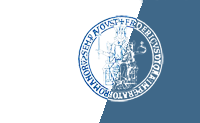Martino, Luigi (2009) DNA QUADRUPLEXES AND PROTEINS: STRUCTURE, STABILITY AND THEIR INTERACTIONS WITH PHARMACOLOGICALLY RELEVANT MOLECULES. [Tesi di dottorato] (Inedito)
|
PDF
Martino.pdf Visibile a [TBR] Amministratori dell'archivio Download (16MB) |
| Tipologia del documento: | Tesi di dottorato |
|---|---|
| Lingua: | English |
| Titolo: | DNA QUADRUPLEXES AND PROTEINS: STRUCTURE, STABILITY AND THEIR INTERACTIONS WITH PHARMACOLOGICALLY RELEVANT MOLECULES |
| Autori: | Autore Email Martino, Luigi luigi.martino@unina.it |
| Data: | 25 Novembre 2009 |
| Numero di pagine: | 97 |
| Istituzione: | Università degli Studi di Napoli Federico II |
| Dipartimento: | Chimica "Paolo Corradini" |
| Scuola di dottorato: | Scienze chimiche |
| Dottorato: | Scienze chimiche |
| Ciclo di dottorato: | 22 |
| Coordinatore del Corso di dottorato: | nome email Vitagliano, Aldo alvitagl@unina.it |
| Tutor: | nome email Giancola, Concetta concetta.giancola@unina.it |
| Data: | 25 Novembre 2009 |
| Numero di pagine: | 97 |
| Parole chiave: | Quadruplex Structures, NMR, ITC, CD, isomerase, |
| Settori scientifico-disciplinari del MIUR: | Area 03 - Scienze chimiche > CHIM/02 - Chimica fisica |
| Informazioni aggiuntive: | Indirizzo del dottorato: Riconoscimento molecolare in processi di interesse biologico ed ambientale |
| Depositato il: | 03 Ago 2010 14:39 |
| Ultima modifica: | 29 Ott 2014 12:17 |
| URI: | http://www.fedoa.unina.it/id/eprint/4066 |
Abstract
In the first part of the thesis my efforts have been focused on the interactions between the DNA quadruplex structures and drugs such as distamycin A and cationic porphyrin. Those drug are able to bind to the quadruplex structure via to completely different binding mode. The distamycin A is a well-know groove binder on the other hand the cationic porphyrin prefers stacking-mode interacting mechanisms. For the previous reasons those molecules are a good starting point, as molecular scaffold, for further chemical optimisations that could enhance their affinity for the quadruplex structures. In a second stage of my PhD studies, I had the possibility to move to the lab of Dr. Maria R Conte at the King’s College of London to further my understanding of protein NMR. In this stimulating environment I started to study the structure and the interaction of the protein SlyD from E.coli. This system represented the possibility to apply all my biophysical skills to the field of the proteins. In my thesis work I faced the study of three different systems, with increasing complexity. All the interactions, that have been characterised, are biological relevant and the study intends to illuminate on their structural and energetic aspects in order to get a deeper understanding of their regulating mechanisms.
Downloads
Downloads per month over past year
 Loading...
Loading...Actions (login required)
 |
Modifica documento |






